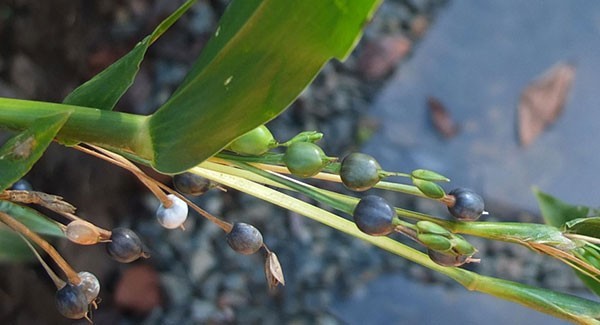In the Bible story, when Job, having obeyed the repeated injunctions of God, had lost everything, he sat down amid the ashes and wept copious tears. In much of the religious literature of Arab, Jewish and Christian cultures we find several plants called ‘Job’s Tears’, especially Coix lacryma-Jobi L., named for his tears.
What to call them
Arab explorers brought this grain to Europe and gave it the name Damu Ayub or the Tears of Job. Linneaus then used it as the scientific name and many western languages use it as the common name. In Asia, where references are different, the names vary much more. In Laos, as in Thailand, the plant is called deuay and a distinction is made between mak deuay and mak deuay hin, with the latter being hard and inedible. But it is also called mak deuay ta kai deuay, (chicken eye), mak deuay ta khouay (eye of the buffalo) depending on the size of the false fruit. In Vietnamese they use the name cu’o’m-gao which can be translated as cereal-bead an interesting term when you remember that Job’s Tears is undoubtedly the oldest cultivated cereal crop in the world.
An Ancient Cereal
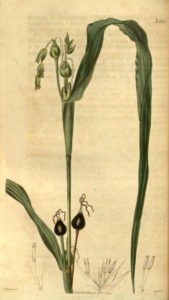
Botanical drawing in Curtiss Magazine, 1824
Originating probably in Myanmar or at least in South East Asia, Coix lacryma-jobi has been cultivated in India for three to four thousand years and in China for two thousand. It was one of the very first cereals, before rice and corn and it has been cultivated continuously as a secondary crop in all the tropical countries of the world.
It grows in clumps that grow to one to three meters in height, the leaves are mostly blade linear with heavy spikes and at maturity, bend to the ground by the weight of the prolific grains. Botanically speaking, these grains are false-fruits consisting of a hard outer layer, an involucre, containing both tiny flowers and the grains pollinated by the wind.
These tear-shaped false fruits vary considerably in size shape and colour. Colours can be ivory white or black and many shades of blue and brown. They are sometimes oblong, sometimes quite round or even long tubular shapes.
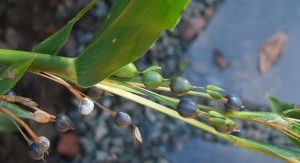
Male and female flowers emerge from the involucres
The surface of the involucre is either smooth and shiny or striated. This shows the great number of varieties of Coix lacryma-jobi. that scientists have reported on thus far. The edible variety which is best known in Laos is the and in neighbouring countries is Coix lacryma-jobi var. ma yuen (Romanet) Stapf. Named after a Chinese general from the first century of the modern era whom the resistance of Vietnamese soldiers that he came to conquer had beaten him and who ate this grain. He then introduced the plant to China.
Gastronomy
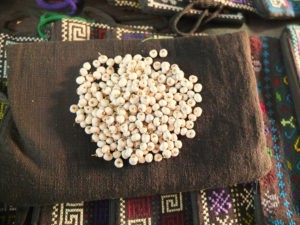
Small and round
However, the edible variety is difficult to prepare as the external pellicule that covers the ‘fruit’ is hard to remove. The Lao use it like rice, when they don’t have enough of that crop, and they also use it to make desserts (nam van) with a base of coconut milk. From October onwards you can try the grains which are boiled and sold as a snack at stalls along the roads. The Vietnamese make a fine, very white flour from the seeds which they used to make cakes for special occasions. Petelot reports that “It is used to nourish children and the elderly and women who have trouble with lactation”. He adds that, “In China they put it in soups and serve it as an accompaniment to duck, chicken and fish.” ( III 276). In China, the grain is fermented to make beer and wine and in Japan, a tea is made from the hard outer covering.
One would think that the consumption of this grain nowadays would be quite small, but the figures make it clear that the cultivation of Job’s Tears is growing in Laos as fast as that of corn. Luang Prabang Province exported 20,000 tonnes last year, mainly to China. All the studies make it quite clear that this grain is rich in proteins and does not contain gluten so it can be eaten by people with food allergies and intolerances and is becoming well-regarded as part of a modern diet.
Pearls of nature
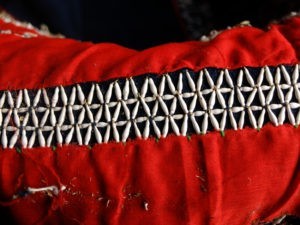
An embroidered band belonging to an Akha tunic
The larger, naturally polished grains, have a fibrous filament running through them, which, when removed, leaves a perfect space for threading the seeds with a needle or a stick. This feature makes them a wonderful material for creating jewellery and embroidery. Tunics, shoes and shoulder bags from ethnicities including Karen, Akha and Hmong are decorated with Job’s Tears. The embroidery patterns are used to distinguish between married and unmarried women and to denote their places in the village society. And of course the tourists enjoy buying the products of these artisans, buying necklaces and bracelets made of Job’s Tears. In the West, Job’s Tears are also used to make rosary beads, which gives the plant another name : Rosary plant.
A “Cold” Grain
In traditional Lao medicine, Job’s Tears, by nature cold and sweet, are considered effective at dissolving kidney stones. Elsewhere the plant is sometimes called deuay niou, niou indicating its use as a medicine for an illness that impedes urination. A tea made from the seeds of Job’s Tear is recommended for beautiful skin and a decoction of the roots is said to be good for menstrual problems. In China, they make a tisane using the husks of the grain or the boiled seeds and a coffee substitute is made with roasted grains. In Chinese traditional medicine this cereal grain is so much utilised that laboratory research has been done to define their pharmacological uses and a study in 1994 has isolated anti-tumour properties.
Common Uses
A plant that has been domesticated by humans for a long time has, of course, many uses. So Job’s tears can be used as feed for cattle and poultry in the same way as corn, and it seems that elephants also love to snack on the long stems full of grains. The outer casings of the grain are also used to improve agricultural soil. Another use, this time musical, comes from some countries in Africa where gourds are covered by strings of Job’s Tears which creates a special sound used as a rhythm accompaniment.
Bibliographie : Petelot, 1954, Les plantes médicinales du Cambodge, du Laos et du Vietnam, 4 tomes, Saigon, Etat du Vietnam.
Share this Post



